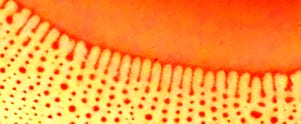The beauty of Marangoni bursting
One of the most beautiful surface tension beasts is the Marangoni bursting. It is also a very simple experiment that you can do with your kids and have fun.
In our previous episodes we introduced the concept of surface tension force and then explained what role it plays in the popular pepper and soap experiment. The fluid flow driven by surface tension is known as the Marangoni effect and today we will describe one beautiful manifestation of it – the Marangoni bursting.
It is interesting that this Marangoni beast, as I like to call it, has not been explored in detail until recently. A research paper was published in 2017 together with a video of this simple experiment.
When I saw this video for the first time, I couldn’t resist to try it at home. It turns out it is quite simple and safe to do it, so that even small kids can play with it.

The recipe is simple:
Fill a plate with cooking oil (a small finger thickness of oil is enough)
Mix 2 mL of isopropyl alcohol and 2 mL (a few drops) of food coloring (i.e., colored water)
With a syringe or pipette put a few drops of alcohol-water mixture on the oil surface.
That’s it! As simple as that. If you are a schoolteacher, you can also find more step-by-step instructions on the Internet.
Unlike the pepper&soap experiment, here the fluid flow keeps going for a long time. If you play with the alcohol-water ratio, you will notice differences in the created shapes and duration of the flows. And if you do not use alcohol at all then nothing happens. Thus, alcohol is obviously the fuel behind this show.
While alcohol is the fuel, its quick evaporation is the engine. The first step in this show is the same as in the pepper&soap experiment – the droplet starts to expand over the oil surface. A new thing here is that while it is spreading, the alcohol evaporates, which changes the alcohol-water ratio along the way. This decrease in the alcohol concentration is faster at the edges of expanding drop because the layer is thinner there.
Since the surface tension depends on the alcohol concentration, the edges, that are now becoming just pure water, increase their surface tension. This increased tension pulls the rest of drop fluid to the rim of the drop, which leads to water accumulation at the rim. But water molecules also strongly pull on their own molecules tangentially to the drop rim. We learned in our previous episode on surface tension that tension would prefer to create a circle.

Eventually the rim must break under the tangential force of water tension and water droplets are formed. These droplets stay connected to the main alcohol-water drop body, but the receding evaporation rim gives them no option but to completely separate from the main drop. This entire dynamic gets a helping hand from the oil beneath because water and alcohol can glide smoothly, without much friction. Other types of surfaces would attract water and alcohol molecules and prevent water drops to escape the main drop.
This fluid dynamics in the Marangoni bursting experiment is revealed in small details. In one of the experiments, we had some water droplets from previous experiments sunk into the oil. These small droplets started to move within the oil in the experiment that followed. The droplets’ shadows help with figuring out the oil flow. Friction between the moving water-alcohol layer and oil drives the upper oil surface flow. But the oil that flows in one direction must change its direction and return. Therefore, the oil close to the water-alcohol rim experiences a circular flow, exposed by the dance of small droplets.

In the same video you can notice hints of rainbow colours. This is a light interference on a thin layer, like colours on soap bubbles. We will play with this in future episodes, but for now it is only important to know that the layer thickness can be deduced from these colours.
It is also fun to explore shapes that are created in this experiment and how to control this process. If you blow air above the surface, the evaporation speeds up, which creates changes in the water droplets formation. You can also release two alcohol-water mixtures side by side and observe their mutual interaction.
There are so many ways how to play with this experiment that you can easily spend lots of time with your kids on this. And remind them to write notes about what they do and see in the experiments.








